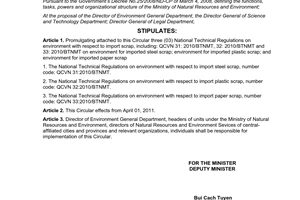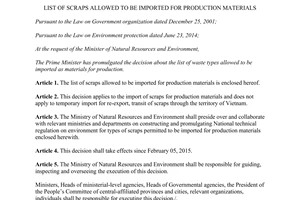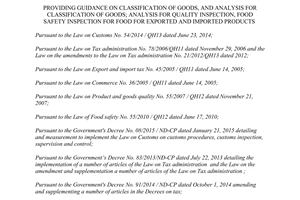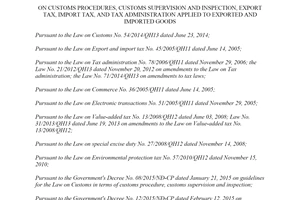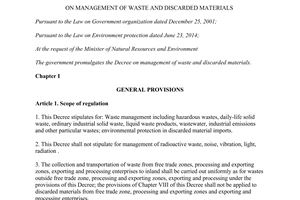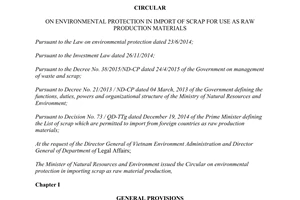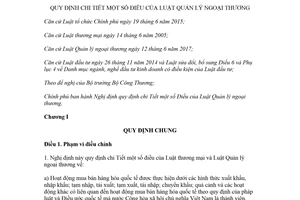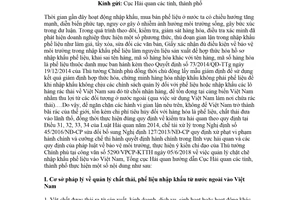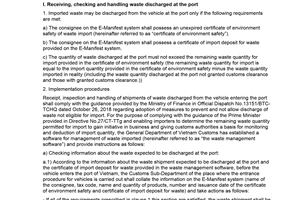Official Dispatch 4202/TCHQ-PC 2018 management import scrap into Vietnam đã được thay thế bởi Official Dispatch 2188/TCHQ-GSQL 2019 promotion solutions to managing preventing import of wastes và được áp dụng kể từ ngày 16/04/2019.
Nội dung toàn văn Official Dispatch 4202/TCHQ-PC 2018 management import scrap into Vietnam
|
MINISTRY OF
FINANCE |
SOCIALIST
REPUBLIC OF VIETNAM |
|
No. 4202/TCHQ-PC Re: Management of import of scrap into Vietnam |
Hanoi, July 17, 2018 |
To: Customs Departments of provinces and cities
Recently, trading and import of scrap in our country have been on a sharp increase, changed complicatedly and caused annoyance to the public. Through monitoring, inspection, supervision and investigation of goods, it has been found that importing enterprises carry out certain fraudulent acts and schemes upon import of scrap such as falsifying, erasing or altering documents and certificates of conformity to environmental protection regulations for import of scrap for production purposes (hereinafter referred to as “certificates of conformity”) in order to legalize the documents required for import of scrap, providing names and HS codes of goods inconsistent with those of scrap in the list issued together with Decision No.73/2014/QD-TTg dated December 19, 2014 of the Prime Minister and collecting, at their discretion, samples used for testing to obtain the testing results proving that the imported goods are not scrap in pursuit of evading scrap management policies or importing waste shipments into Vietnam but refusing to receive such shipments and leave them backlogged in the seaports for gain from overseas entities (by turning Vietnam into a waste dump). As for that reason, for the purpose of preventing the above-mentioned acts, not letting Vietnam become the landfill of the world, saving costs of disposal of scrap and waste imports and implementing the regulation on customs inspection as prescribed in Article 31, 32, 33 and 34 of the 2014 Customs Law, sanctions prescribed in Decree No.45/2016/ND-CP on amendments to Decree No.127/2013/ND-CP which prescribes penalties for administrative violations and enforcement of administrative decisions on customs and the law on environmental protection, and following the guidelines of the Prime Minister given in Official Dispatch No.5290/VPCP-KTTH dated June 05, 2018 regarding strict management of scrap imported into Vietnam, the General Department of Vietnam Customs instructs Customs Departments of provinces and cities to carry out the following tasks:
I. Legislative bases for management of waste and scrap imports into Vietnam
1. A kind of materials discharged in production, business, service, daily human and other activities is considered waste as prescribed in clause 12 Article 3 of the Law on Environmental Protection dated June 23, 2014.
Apart from scrap mentioned in clause 2 in this Section, waste shall be prohibited from being imported and transit in any form as prescribed in clause 9 in Article 7 of the Law on Environmental Protection.
2. Materials that are available after collection, sorting and selection of materials or products discarded during production or consumption activities for use as materials for another manufacturing process are considered scrap as prescribed in clause 16 Article 3 of the Law on Environmental Protection.
Scrap materials subject to customs clearance procedures for import must conform to the following requirements:
- They must be in the list of scrap permitted for import issued by the Prime Minister (as prescribed in clause 1 in Article 76 of the Law on Environmental Protection). This requirement is now subject to the Prime Minister’s Decision No.73/2014/QD-TTg dated December 19, 2014 prescribing the list of scrap permitted for import as materials for production purpose;
- The national technical regulations on environment for these scrap materials (as prescribed in clause 1 in Article 76 and clause 2 in Article 141 of the Law on Environmental Protection) must be made available. This requirement is now subject to the Circular No.43/2010/TT-BTNMT dated December 29, 2010 of the Ministry of Natural Resources and Environment on national technical regulations on environment;
- They must be imported within the import quota by enterprises holding the certificate of conformity (as prescribed in clause 2 Article 76 of the Law on Environmental Protection)
II. Actions taken by customs authorities upon implementation of entry procedures applied to means of transport carrying scrap and used goods characterized as scrap
The customs sub-department receiving and carrying out customs handling of vessel documents on entry shall analyze the information about goods on the e-manifest system as per clause 1 Article 67 of the Government’s Decree No.08/2015/ND-CP dated January 21, 2015 prescribing details and methods for enforcement of the Customs Law regarding customs procedure, inspection, supervision and control which is amended or supplemented in clause 38 Article 1 of the Government’s Decree No.59/2018/ND-CP dated April 20, 2018 with special attention paid to strict inspection of the followings:
1. On completing the declaration on the e-manifest system, all detailed information on the importing enterprise, including its name, tax code, address, number of certificate of conformity, etc and information on goods such as type of scrap, HS code containing at least 4 digits must be provided For instance, declaring “plastic scrap” or “paper scrap” instead of "scrap" having general meaning; avoid using the following terms having general meanings such as general cargo, freight of all kinds, FAK, said to contain, STC, etc
In case of failure to do so, such declaration shall be rejected and the requesting customs declarant shall be informed of reasons for such rejection and requested to submit an additional declaration through the national single-window portal.
2. Information declared on the e-manifest system must be reviewed and analyzed within 4 working hours of receipt of information declared on the e-manifest system, and then processed as follows:
a) If having grounds for determining that goods aboard the vessel are scrap as prescribed in clause 12 Article 3 of the Law on Environmental Protection, the customs sub-department shall immediately notify the shipping line and port operator that they are not allowed to discharge those goods at the port and request the shipping line to take those goods out of the Vietnamese territory, and then any take legally prescribed action against violations;
b) In case a ship has not yet arrived at the port or has already arrived at the port in Vietnam but not yet unloaded goods at the port yard and the customs sub-department has been informed that goods aboard the ship is declared as scrap on the e-manifest system, they shall check whether the importer registered on the e-manifest system is present in the list of enterprises holding unexpired certificates of conformity posted on the V5 e-clearance system of the General Department of Customs:
b.1) If the importer on the e-manifest system is not found in the aforesaid list, the customs sub-department shall immediately notify the shipping line and port operator that they are not allowed to discharge the scrap shipments at the port and request the shipping line to take those shipments out of the Vietnamese territory.
b.2) If the importer on the e-manifest system is found in the aforesaid list and goods declared on the e-manifest system are considered scrap already having national technical regulations on environment, the customs sub-department shall carry out the procedures as regulated.
c) In case a ship has not yet arrived at the port or has already arrived at the port in Vietnam and goods aboard the ship have not yet been discharged to the port yard and have been declared on the e-manifest system as used goods, not scrap but are characterized as scrap (e.g. USED woven jumbo bags, USED pr film, USED tyre, etc.,) and the importer is not present in the aforesaid list posted on the V5 e-clearance system, and these goods are considered scrap but have not had any national technical regulation on environment, the custom sub-department shall put such importer on the list of enterprises requiring special control and carry out the customs procedures as prescribed in clause 2 in Section II herein.
III. Customs procedures applied to scrap imported from foreign countries and imported goods declared as used goods but characterized as scrap
1 . With regard to goods declared as scrap imported from foreign countries
a) Customs declaration registration:
Customs authorities shall not grant the customs declaration registration for goods claimed as scrap to enterprises not having certificates of conformity.
b) Customs dossier inspection:
The customs sub-department where the customs declaration is registered shall check the validity of the customs dossier and collate the information stated in the certificate of conformity, written notification of imported scrap shipment, certificate of import deposit for scrap, authorization contract (if any) and certificate of conformity with national technical regulations on environment for imported scrap shipment and other documents included in the customs dossier.
b.1) Checking the certificate of conformity (certificate of scrap import)
- The certificate of scrap import must be the certified true copy.
- Check the format and validity of the certificate of scrap import issued in accordance with regulations in Circular No.41/2015/TT-BTNMT dated September 9, 2015 of the Ministry of Natural Resources and Environment on environmental protection in import of scrap for production purpose
- Collate the following information: issuance authority, certificate no. , issuance date, name of organization or individual directly using scrap as materials for production/name of organization or individual authorized to import scrap, name and address of the entity using scrap for production purpose or address of the warehouse or yard storing imported scrap, scrap HS description and code, allowable imported volume and effective period of the certificate of scrap import
- With regard to the enterprise authorized to import scrap, check the certified copy of the authorization contract signed with an organization or individual using scrap as materials for production who possesses a certificate of scrap import and check the certified copy of unexpired certificate of scrap import of such authorized enterprise
b.2) Checking the written notification of the imported scrap shipment
- Check the format and validity of the certified copy of such written notification according to Appendix 12 issued together with Circular No.41/2015/TT-BTNMT.
- Collate the written notification submitted by the customs declarant with the one kept on the V5 e-clearance system in respect of the following information: notification no. , issuance date, signatory, name and address of organization or individual, scrap HS description and code, total allowable imported volume specified in the certificate of scrap import, volume of scrap imported successfully and those under the customs procedures.
b.3) Checking the certificate of import deposit for scrap as prescribed in Article 58 and 59 of Decree No.38/2015/ND-CP dated April 24, 2015 of the Government on management of waste and scrap
- Such certificate must be a certified copy and issued by Funds for environmental protection of Vietnam or Commercial Bank at which the deposit is made.
- The deposit must be made at least 15 days before the procedures for clearance of imported scrap are carried out.
- Deposit amount is specified below:
+ A deposit of 10% of total value of imported scrap shipment must be made if the weight of imported iron and steel scrap is less than 500 tonnes.
+ A deposit of 15% of total value of imported scrap shipment must be made if the weight of imported iron and steel scrap is from 500 to less than 100 tonnes.
+ A deposit of 20% of total value of imported scrap shipment must be made if the weight of imported iron and steel scrap is from 1,000 tonnes.
+ A deposit of 15% of total value of imported scrap shipment must be made if the weight of imported paper and plastic scrap is less than 100 tonnes.
+ A deposit of 18% of total value of imported scrap shipment must be made if the weight of imported paper and plastic scrap is from 100 to less than 500 tonnes.
+ A deposit of 20% of total value of imported scrap shipment must be made if the weight of imported paper and plastic scrap is from 500 tonnes.
b.4) Checking the certificate of conformity with national technical regulations on environment for imported scrap shipment to ensure the certification body must be found in the list of certification bodies appointed by the Ministry of Natural Resources and Environment (inspect the issuance date and effective period of the appointment decision by Ministry of Natural Resources and Environment) and check the format of the original certification as well as verify whether the information stated in such certificate is consistent with that provided in the customs declaration and relevant documents.
b.5) Collating and comparing data including the quantity and HS code of the scrap imported by the enterprise provided in the customs dossier (customs declaration and relevant documents) with information stated in the certificate of scrap import, written notification of the import of scrap, certificate of import deposit for scrap and certificate of conformity with technical regulations on environment
c) Physical inspection of goods:
c.1) The customs authority shall carry out the physical inspection of all shipments claimed as imported scrap.
c.2) Inspection location:
The physical inspection of goods shall be carried out at the Customs Sub-department at the entry checkpoint (hereinafter referred to as “entry checkpoint Customs Sub-department”) as prescribed in clause 4 in Article 10 of Circular No.41/2015/TT-BTNMT.
In case the importing enterprise registers the customs declaration at the Customs Sub-department other than the one mentioned above, the receiving Customs Sub-department shall send a written notice or a fax asking the entry checkpoint Customs Sub-department to cooperate with the responsible Customs Inspection Sub-department/Customs Inspection Department (hereinafter referred to as “Customs Inspection Authority”) in carrying out the physical inspection and sampling.
If the entry checkpoint is equipped with a closed circuit television system, the physical inspection of goods shall be carried out in the area under such system’s surveillance.
c.3) Before presenting goods for inspection and typical sampling, the customs declarant must inform, whether in writing or through the national single-window system, to the Customs Sub-department where goods are stored and the appointed certification body of the time and place of the inspection and sampling.
c.4) Right after being informed, the Customs Sub-department at the entry checkpoint where the goods are stored shall write an inspection requesting note and send it directly or by fax to the responsible Customs Inspection Authority (according to form no.01/PYCKD/2018 issued thereto).
After receiving the requesting note or fax, such Customs Inspection Authority shall arrange for their inspectors and technical equipments to cooperate with customs officers in carrying out the inspection and sampling.
The Customs Inspection Authority shall only inspect goods having national technical regulations on environment.
c.5) Form, extent and method of inspection
Inspection for the purpose of determining whether the information in the customs declaration is consistent with the real condition of imported goods shall be carried out by customs officers of the entry checkpoint Customs Sub-department and customs inspectors of the Customs Inspection Authority.
c.5.1) Visual inspection or other on-site physical inspection carried out by using analysis equipment shall be carried out by the Customs Inspection Authority and entry checkpoint Customs Sub-department according to Decision No.73/2014/QD-TTg and national technical regulations on environment specified in Circular No.43/2010/TT-BTNMT. If having sufficient grounds for determining the imported scrap shipment fails to conform to provisions of the Customs Law and the Law on Environmental Protection, the above-mentioned Department shall take actions accepted by Laws.
c.5.2) In case results of visual inspection and on-site physical inspection carried out by using analysis equipment fails to determine whether the imported scrap are conformable to provisions of the Customs Law and the Law on Environmental Protection, the Customs Inspection Authority shall cooperate with the entry checkpoint Customs Sub-department in collecting typical samples for analysis and assessment purpose. The sampling shall comply with regulations in Circular No.43/2010/TT-BTNMT.
Physical inspection and sampling of goods by the Customs Inspection Authority shall be carried out in conjunction with the sampling by the certification body appointed by the Ministry of Natural Resources and Environment.
c.5.3) During the physical inspection and typical sampling of goods, the customs officer overseeing the sampling process shall take photos of inspection points, collect samples of imported goods, and video the whole inspection and sampling process, from the opening of goods container (with regard to containerized goods) or the commencement of inspection of goods (with regard to bulk cargos) to the completion of inspection and sampling. For shipments requiring extra time for inspection, only photos showing inspection contents and methods as well as real conditions of goods for inspection, handling complaints or filing of a lawsuit shall be taken. Photos of inspection and sampling points shall be sent to the mail box at the address while the video of the inspection and sampling is deposited with the entry checkpoint Customs Sub-department for the purpose of inspection, handing complaints or filing of a lawsuit.
c.5.4) At the end of the physical inspection of goods, the in-charge customs inspector shall write an inspection result report according to form no.06/PGKQKT/GSQL issued together with Circular No.38/2015/TT-BTC dated March 25, 2015 of the Ministry of Finance prescribing customs procedures, inspection and supervision, import and export tariff and management of duties on imported and exported goods (which is amended in Circular No.39/2018/TT-BTC dated April 20, 2018). The inspectors of the Customs Inspection Authority shall sign for certification at item no.4 in the part “manual inspection” in section II of the inspection result report.
For goods claimed as scrap that are present in the list provided in Decision No.73/2014/QD-TTg but do not have any national technical regulation on environment, the customs authority shall determine that there are not enough grounds for clearance of those goods.
c.5.5) For goods of which typical sampling is required, at the end of the sampling, the customs inspector shall make a written document certifying such sampling according to form no.02/BBLM-PL issued thereto which is endorsed by the customs declarant, customs officers of the Customs Inspection Authority and representative of the certification body. The written document certifying the sampling must specify the sampling time and position (samples may be collected in a container or from a shipment), sampling method and the quantity of sample (quantity and weight of samples conforming to regulations in Circular No.43/2010/TT-BTNMT) and serial number of the container or means of transport carrying scrap goods.
c.5.6) The customs officer must apply security seals to the samples after sampling. One sample shall be sent to the Customs Inspection Authority for its inspection and assessment of compliance with provisions of the Customs Law and the Law on Environmental Protection. One sample shall be sent to the appointed certification body. One sample shall be kept at the entry checkpoint Custom Sub-department. Sample storage time shall be subject to the Circular No.14/2015/TT-BTC dated January 30, 2015.
c.6) The visual inspection of goods and on-site inspection by using testing equipment shall be carried out within 8 working hours starting from the customs declarant’s presentation of all goods for inspection. In case of goods imported in large quantities, of various kinds or complicated inspection, physical inspection duration shall not exceed 2 working days.
In cases where analysis and assessment of criteria for determination of conformity with technical regulations on laboratory environment, the Customs Inspection Authority may request analysis and assessment of criteria failing to meet conformity requirements by certification body appointed by the Ministry of Natural Resources and Environment as the basis for its notification of inspection results. The Customs Inspection Department shall make a consolidated report on cases in which analysis is carried out in excess of the prescribed time.
c.7) Actions taken in response to inspection results provided by the Customs Inspection Authority:
c.7.1) If the inspection results show that the imported scrap conforms to provisions of the Customs Law and the Law on Environmental Protection, the customs sub-department shall continue to carry out the customs procedure as regulated;
c.7.2) If the inspection results show that the imported scrap fails to conform to provisions of the Customs Law and the Law on Environmental Protection, the customs sub-department shall take actions as regulated.
2. With regard to goods declared as used goods but characterized as scrap
a) Physical inspection of all goods shipments is required. If the VNACCS/VCIS system does not have the red channel, the customs sub-department shall move goods to other channels for physical inspection.
b) Before presenting goods for inspection and typical sampling, the customs declarant must inform, whether in writing or through the national single-window system, to the Customs Sub-department where the goods are stored of the time and place for the inspection and sampling.
c) Right after being inform, the Customs Sub-department at the entry checkpoint where the goods are stored shall write a note requesting for inspection according to form no.01/PYCKD/2018 issued thereto and send it directly or through fax to the responsible Customs Inspection Authority.
After receiving the requesting note or fax, such Customs Inspection Authority shall arrange for their inspectors and technical equipments to cooperate with customs officers in carrying out inspection and sampling.
d) The Customs Inspection Authority in collaboration with the Custom Sub-department shall carry out visual inspection and on-site physical inspection by using analysis equipment and take the following actions:
d.1) If it is determined that the imported goods are used goods in the list of goods prohibited for import prescribed in the Government’s Decree No.69/2018/ND-CP dated May 15, 2018 specifying implementation of a number of articles of the Law on management of foreign commerce, the Customs Sub-department where the customs declaration is registered shall take any legally permissible action against violations;
d.2) If results of the physical inspection of goods show that the used goods are not prescribed in point d.1 mentioned above and identified as waste as prescribed in clause 12 Article 3 of the Law on Environmental Protection, the Customs Sub-department where the customs declaration is registered shall take any legally permissible action against violations;
d.3) If results of the physical inspection of goods show that the inspected goods are used goods declared by the customs declarant as production materials, the customs sub-department shall carry out inspection as prescribed in clause 1 in Section III herein.
dd) If results of visual inspection and on-site physical inspection by using testing equipment fail to provide sufficient grounds for determining whether goods satisfy import requirements, the entry checkpoint Customs Sub-department shall cooperate with Customs Inspection Authority in carrying out sampling of goods for analysis and inspection purpose.
e) During the physical inspection and typical sampling of goods, the customs officer overseeing sampling shall take photos of inspection points, collect samples of imported goods, and video the whole inspection and sampling, from the opening of goods container (with regard to containerized goods) or commencement of inspection of goods (with regard to bulk cargos) to the completion of inspection and sampling. For shipments requiring extra time for inspection, only photos showing inspection contents and methods as well as real conditions of goods for inspection, handling complaints or filing of a lawsuit shall be taken. Photos of inspection and sampling points shall be sent to the mail box at the address [email protected] while the video of the inspection and sampling is deposited with the entry checkpoint Customs Sub-department for the purpose of inspection, handing complaints or filing of a lawsuit.
g) At the end of the physical inspection of goods, the in-charge inspector shall write an inspection result report according to form no.06/PGKQKT/GSQL issued together with Circular No.38/2015/TT-BTC which is amended in Circular No.39/2018/TT-BTC dated April 20, 2018. The inspectors of the entry checkpoint Customs Sub-department and Customs Inspection Authority shall sign for certification at item no.4 in the part “manual inspection” in section II of the inspection result report. If the goods are claimed as waste, the inspection result report form must provide details of goods such as specification, quality, components and functions of goods.
h) For goods requiring typical sampling, at the end of the sampling, the customs inspector shall make a written document certifying such sampling according to form no.02/BBLM-PL issued together with Circular No.38/2015/TT-BTC which is amended in Circular No.39/2018/TT-BTC dated April 20, 2018 which is endorsed by the customs declarant, customs officers of the entry checkpoint Customs Sub-department and Customs Inspection Authority. The written document certifying the sampling must specify the sampling time and position (samples may be collected in a container or from a shipment), sampling method and the quantity of sample (the quantity and weight of samples) and serial number of the container or means of transport carrying goods.
i) The customs officer must apply security seals to the samples after sampling. One sample shall be sent to the Customs Inspection Authority for its analysis and inspection. One sample shall be kept at the entry checkpoint Custom Sub-department. Sample storage time is subject to the Circular No.14/2015/TT-BTC dated January 30, 2015.
k) The visual inspection of goods and on-site physical inspection by using testing equipment shall be carried out within 8 working hours starting from the customs declarant’s presentation of all goods for inspection. In case of goods imported in large quantities, of various kinds or complicated inspection, physical inspection duration shall not exceed 2 working days.
For cases in which laboratory analysis and assessment of goods are required, the Customs Inspection Authority may request analysis and assessment of criteria failing to meet conformity requirements by certification body appointed by relevant ministries as the basis for its notification of inspection results. The Customs Inspection Department shall make a consolidated report on cases in which analysis is carried out in excess of the prescribed time.
l) Actions taken in response to the results informed by the Customs Inspection Authority shall be subject to point d in clause 2 in Section III herein.
IV. Handling of scrap goods and used goods characterized as scrap which are left backlogged within the customs controlled area
Customs Departments of provinces and cities where goods are backlogged shall take responsibility to:
1. carry out necessary review of the backlogged situation and call for cooperation of the enterprise/shipping line/shipping agent in identifying the goods’ owner and classifying goods according to their type, quantity, volume, components, storage time and place;
2. collect and analyze information about, investigate, verify as well as proactively check, even in the absence of the customs declarant as per Article 34 of the Customs Law dated June 23, 2014, any shipment showing signs of violations or any abuse of permission for scrap import for smuggling or illegal transport of goods across the border;
3. According to results of the above-mentioned activities, backlogged goods shall be handled as follows:
a) With respect to goods identified as waste and hazardous waste:
a.1) if they are identified as exhibits used in criminal cases, actions for handling this kind of goods shall be subject to provisions of the Law on Criminal Procedure;
a.2) if they are not identified as exhibits used in criminal cases, penalties for administrative violations shall be imposed and this kind of goods shall be forcibly moved out of Vietnam.
b) With respect to goods identified as scrap appearing in the list provided in Decision No.73/2014/QD-TTg:
b.1) they shall be handled in case any national technical regulation on environment applied to this kind of goods is available
b.1.1) if the consignee defined on the e-manifest system is the enterprise who holds a certificate of conformity, that consignee shall be urged to carry out the legally required customs procedure;
b.1.2) if the consignee defined on the e-manifest system is the enterprise who does not hold a certificate of conformity, the shipping line/shipping agent to notify shall be required to notify the consignee of their ineligibility for carrying out the entry procedures and to move those goods out the Vietnamese territory.
b.2) in case no national technical regulation on environment applied to this kind of goods is available, the shipping line/shipping agent shall required to notify the consignee that the customs authority has no grounds for considering the clearance of this kind of goods and to move those goods out of the Vietnamese territory.
4. Scrap goods backlogged in the customs controlled area shall be handled under the guidance of the Customs General Department provided in Official Dispatch No.2443/TCHQ-GSQL dated July 05, 2018 as follows:
a) Scrap goods backlogged in ports on which any action has not yet been taken or is in progress under the guidance provided in Official Dispatch No.2443/TCHQ-GSQL dated May 07, 2018 shall be handled as guided in clause 1, 2 and 3 in this Section.
b) For scrap goods backlogged in ports that have been handled as guided in Official Dispatch No.2443/TCHQ-GSQL dated May 07, 2018, the contents and results of handling of each shipment shall be sent to the Customs General Department (through the Customs management and supervision department).
V. Implementation
1. This Official Dispatch shall replace Official Dispatch No.8154/TCHQ-GSQL dated September 08, 2015 regarding inspection of imported scrap without the national technical regulations on environment, Official Dispatch No.2443/TCHQ-GSQL dated May 07, 2018 on handling scrap goods backlogged in the customs controlled area and Official Dispatch No.3738/TCHQ-GSQL dated June 26, 2018 of the Customs General Department on management of imported scrap.
2. Entities affiliated to the General Department of Customs shall take responsibility to thoroughly grasp and implement this Official Dispatch. While on duty, annoyance, harassment, negative behaviors and unnecessary extension of time shall be prohibited.
3. Specific tasks
3.1. Customs Departments of provinces and cities
a) Notify the shipping line or shipping agent that they must declare information on the e-manifest system as prescribed in clause 1 Section II herein.
b) Notify the scrap importer that:
b.1) the custom authority shall carry out the customs procedures applied to scrap imported from foreign countries only to the extent that they are in the Prime Minister’s list of goods permitted for import, national technical regulations on environment applied to these scrap are available, and they are imported within the import quota by the enterprise holding a certificate of conformity;
b.2) goods that are scrap gypsum, scrap glass or chemical elements doped for use in electronics, in the form of discs, wafers or similar forms shall be shown as “PL&name of goods" at the column "Description"
b.3) detailed information on the importing enterprise including name, tax code, address and number of the certificate of conformity and goods information including type of scrap, HS code containing at least 4 digits shall be given to the exporter/carrier for completing their declaration on the e-manifest system.
3.2. Anti-Smuggling and Investigation Department
a) Preside over and instruct Customs Departments of provinces and cities to implement plans for investigation, verification and handling of violations arising from scrap import activities, with emphasis on:
a.1) collecting information, data and documents concerning the import of iron, steel, plastic or paper scrap from foreign countries into Vietnam in the past few years and carrying out necessary review and examination to discover any alleged violation;
a.2) presiding over and instructing entities concerned to investigate and verify cases showing suspicious signs of violations in import of scrap and handling violations in accordance with provisions of laws.
b) Liaise with and assist Customs Department of provinces and cities in verifying foreign documents or materials on imported scrap shipment that reveal any sign of violations against laws.
c) Cooperate with the General Department’s Office in online and focused monitoring of inspection and sampling of scrap imported from foreign countries into Vietnam and imported used goods having the scrap's feature but not in the list of goods permitted to be imported as materials for production issued together with Decision No.73/2014/QD-TTg.
3.3. Customs Inspection Department
a) Prepare plans and methods for performing the tasks assigned herein in such a way that goods are not stagnated at the checkpoint
b) Allocate permanent inspectors at the checkpoint for cooperation in inspection and sampling
3.4. Risk Management Department
a) Assist in the analysis of information declared on the e-manifest system and transfer of channel for physical inspection of shipments suspected as imported waste or scrap
b) Cooperate with the Custom IT and Statistic Department, Customs Management and Supervision Department and Customs Inspection Department in developing standards for eligibility inspection and not allowing enterprises importing scrap without certificate of conformity to register customs declaration.
3.5. Customs IT and Statistics Department
Design applications on the System that:
a) reject the customs declaration registered on the VANCCS/VCIS system for scrap imported by the enterprise without certificate of conformity;
b) allow enterprises to be updated on or have access to the list of enterprises holding certificates of conformity and written notification of the imported scrap shipment.
3.6. Post-clearance Audit Department
Preside over and cooperate with the Anti-Smuggling and Investigation Department, Risk Management Department, Customs Inspection Department and Inspection Department in collecting and analyzing information, preparing and implementing plans for key inspection of use of scrap as materials for production and taking actions against violations relating to use of scrap for other purposes as stated in the issued certificate of scrap import.
3.7. Customs Management and Supervision Department
a) Monitor, inspect and urge Customs Departments of provinces and cities to carry out the procedures for importing scrap as instructed in this Official Dispatch and relevant documents
b) Cooperate with the Customs IT and Statistic Department in updating the list of enterprises having certificates of conformity and written notification of the imported scrap shipment on the V5 e-clearance system
The General Department of Customs shall, by this document, request entities to thoroughly grasp and comply with this Official Dispatch. Should there be any difficulty arise in the course of implementation, entities concerned should promptly notify the General Department (through the Customs Management and Supervision Department) for its further instruction.
|
|
DIRECTOR
GENERAL |
Form No.01/PYCKD/2018
|
CUSTOMS DEPARTMENT
OF…. |
SOCIALIST
REPUBLIC OF VIETNAM |
|
No…../…….. |
…., date (dd/mm/yyyy) |
INSPECTION REQUESTING NOTE
(Issued together with Official Dispatch No.4202/TCHQ-PC dated July 17, 2018 of the General Department of Customs)
To:…………………………………………
1. Name of goods declared: ……………………………………………………………
2. HS code of goods declared: ……………………………………………………………
3. Customs declaration no…… dated………….
4. Importing/exporting company:…………………………………………………….
5. Enclosure:
|
(a) Customs declaration (copy) |
: Yes □ |
No □ |
|
(b) Commercial contract (copy) |
: Yes □ |
No □ |
|
(c) Relevant technical documents (copy) |
: Yes □ |
No □ |
|
(d) Inspection certificate (copy, if any) |
: Yes □ |
No □ |
|
(e) C/O (if any) |
: Yes □ |
No □ |
|
(f) Results of physical inspection of goods (copy) |
: Yes □ |
No □ |
|
(g) Documents relating to specialized inspection (if available, specify the type of the document): ……………………………………………………………………………………………………………… |
||
6. Proposed time of cooperation in physical inspection: ………………………………
7. Place of physical inspection: ………………………………………………
8. Requested inspection: tick the appropriate checkbox and give required details of each requested inspection:
|
(a) Inspection of HS code |
□ |
|
(b) Inspection for identification of name/type of precursor or prohibited substance: clearly specify name and type of prohibited substance ………………………………………….. |
□ |
|
(c) Specialized inspection in respect of ............ (specify the extent of the inspection) For instance: food safety and quality and quarantine in accordance with regulations in ………………………..(name of the document) |
□ |
|
(d) Other inspection matters (clearly specify where applicable): ……………………………………. |
|
|
CUSTOMS OFFICER |
DIRECTOR |
Note:
Form No.02/BBLM-PL
|
CUSTOMS DEPARTMENT
OF ….. |
SOCIALIST
REPUBLIC OF VIETNAM |
|
No…../…….. |
(dd/mm/yyyy) |
IMPORTED SCRAP SAMPLING RECORD
(Issued together with Official Dispatch No.4202/TCHQ-PC dated July 17, 2018 of the General Department of Customs)
1. Customs declaration no/Bill of lading no.…… dated………….
2. Customs Sub-department at which the customs declaration is registered: …………..
3. Mode of physical inspection of goods (inspection exemption, ratio inspection or whole inspection):
4. Customs Sub-department at the place where samples are collected: …………………..
5. Person in charge of sampling:
+ Custom officer of the Customs Sub-department at the place where samples are collected: ................
+ Inspector: ………………..
+ Representative of the certification body: ............................
+ Representative of goods’ owner: …………………..
6. Sampling location: …………………………………………………….
7. Time of sampling: (hh:mm) …… (dd/mm/yyyy)
8. Sampling method: ………………………….
9. Sample name: ………………………………………..
10. Sample quantity: …………………………………..
11. Sample weight: …………………………………..
12. Sample details (size and characteristics): ............................................................
.......................................................................................................................
.......................................................................................................................
13. Sample security seal and inspection purposes and requirements:
|
No. |
Agency in charge |
Quantity of sample |
Weight of sample |
Sealing no. |
Inspection purposes and requirements |
|
1 |
Checkpoint Customs Sub-department |
|
|
|
|
|
2 |
Custom Inspection Authority |
|
|
|
|
|
3 |
Certification body |
|
|
|
|
14. Serial number of the container or means of transport carrying scrap goods:.............
...................................................................................................................................
|
(11) CHECKPOINT
CUSTOMS SUB-DEPARTMENT |
(13) CERTIFICATION
BODY |
|
(12) INSPECTION
AUTHORITY |
(14) REPRESENTATIVE
OF GOODS’ OWNER |
------------------------------------------------------------------------------------------------------
This translation is made by THƯ VIỆN PHÁP LUẬT and
for reference purposes only. Its copyright is owned by THƯ VIỆN PHÁP LUẬT
and protected under Clause 2, Article 14 of the Law on Intellectual Property.Your comments are always welcomed
